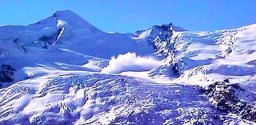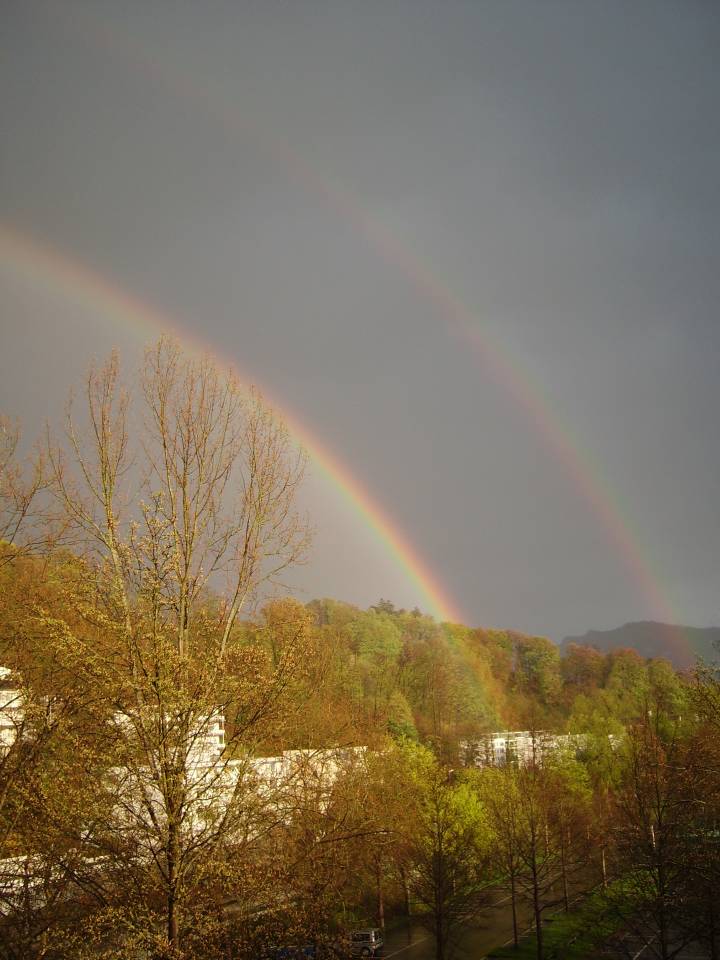SWITZERLAND
Weather
Travelguide
Destinations
Transport
Cities
Government
Cantons
History
Education
Mentality
Religions
Music
Sports
Swiss Climate and Weather
Switzerland has a temperate climate in the populated areas, but mountain peaks in the alps are buried under eternal ice and snow. On the southern side of the alps the climate is a little bit warmer than in the north, but the really important thing to consider is that the alps form a barrier that separates two completely different aspect of a weather situation.
For example there may be a high-pressure area in Italy and low pressure in central Europe, so there will be southern wind crossing the alps. While ascending in southern Switzerland the air will get cooler, vapour will condensate and there will be rain. North of the alps the falling wind will be dry and warm (föhn). Often föhn wind brings a little sunshine in the Rhine valley between Chur and Lake Constance and in the Reuss valley from Altdorf to Lucerne while there are clouds over northern Switzerland. The same effect can of course also be observed in opposite direction.
When consulting a weather forecast for Switzerland it is therefore very important to focus exactly on the correct region.
Typical Temperatures in Switzerland
| Location | Height above sea level |
Winter (January) | Summer (July) | |||||||
|---|---|---|---|---|---|---|---|---|---|---|
| Minimum | Mean Value | Mean Value | Maximum | |||||||
| m | ft | ° C | ° F | ° C | ° F | ° C | ° F | ° C | ° F | |
| Geneva | 375 | 1230 | -17 | 1 | 1.1 | 34 | 19.2 | 67 | 35 | 95 |
| Lausanne | 447 | 1467 | -17 | 1 | 0.5 | 33 | 18.2 | 65 | 33 | 91 |
| Montreux | 372 | 1220 | -17 | 1 | 1.1 | 34 | 19.0 | 66 | 33 | 91 |
| Sion | 491 | 1611 | -17 | 1 | 0.1 | 32 | 19.2 | 67 | 35 | 95 |
| Zermatt | 1616 | 5302 | -26 | -15 | -5.5 | 22 | 12.6 | 55 | 27 | 81 |
| Neuchâtel | 479 | 1572 | -19 | -2 | -0.2 | 32 | 18.4 | 65 | 35 | 95 |
| La Brévine | 1043 | 3422 | -33 | -27 | -4.1 | 24 | 13.2 | 56 | 29 | 84 |
| Bern | 540 | 1772 | -22 | -8 | -1.0 | 30 | 17.4 | 63 | 33 | 91 |
| Interlaken | 564 | 1850 | -22 | -8 | -0.4 | 31 | 16.6 | 62 | 31 | 88 |
| Jungfraujoch | 3454 | 11332 | -37 | -35 | -14.2 | 6 | -1.8 | 29 | 10 | 50 |
| Basel | 260 | 853 | -23 | -9 | 1.3 | 34 | 18.8 | 66 | 35 | 95 |
| Aarau | 382 | 1253 | -24 | -11 | -0.5 | 31 | 17.3 | 63 | 33 | 91 |
| Zurich | 408 | 1339 | -24 | -11 | -0.1 | 32 | 17.7 | 64 | 35 | 95 |
| Schaffhausen | 390 | 1280 | -24 | -11 | -1.1 | 30 | 17.2 | 63 | 33 | 91 |
| Frauenfeld | 420 | 1378 | -24 | -11 | -0.8 | 31 | 17.7 | 64 | 33 | 91 |
| Kreuzlingen | 403 | 1322 | -23 | -9 | -0.5 | 31 | 17.9 | 64 | 33 | 91 |
| St. Gallen | 676 | 2218 | -24 | -11 | -1.8 | 29 | 15.6 | 60 | 30 | 86 |
| Mount Säntis | 2502 | 8209 | -31 | -24 | -8.6 | 17 | 5.0 | 41 | 18 | 64 |
| Lucerne | 435 | 1427 | -22 | -8 | -0.2 | 32 | 17.9 | 64 | 33 | 91 |
| Mount Pilatus | 2109 | 6919 | -29 | -20 | -7.3 | 19 | 7.8 | 46 | 23 | 73 |
| Altdorf | 447 | 1467 | -22 | -8 | 0.5 | 33 | 17.5 | 64 | 35 | 95 |
| Glarus | 472 | 1549 | -24 | -11 | -1.9 | 29 | 16.6 | 62 | 33 | 91 |
| Mount Rigi | 1797 | 5896 | -26 | -15 | -4.3 | 24 | 9.8 | 50 | 26 | 79 |
| Mount Titlis | 3239 | 10,627 | -35 | -33 | -12.9 | 9 | -0.3 | 31 | 12 | 53 |
| St. Gotthard | 2109 | 6919 | -29 | -20 | -7.3 | 19 | 7.8 | 46 | 23 | 73 |
| Chur | 585 | 1919 | -22 | -8 | -0.8 | 31 | 17.3 | 63 | 35 | 95 |
| Arosa | 1739 | 5705 | -26 | -15 | -5.1 | 23 | 10.2 | 50 | 27 | 81 |
| Davos | 1560 | 5118 | -30 | -22 | -6.6 | 20 | 12.0 | 54 | 27 | 81 |
| St. Moritz | 1775 | 5824 | -26 | -15 | -6.7 | 20 | 11.1 | 52 | 27 | 81 |
| Scuol | 1287 | 4223 | -26 | -15 | -5.8 | 22 | 14.9 | 59 | 27 | 81 |
| Bellinzona | 230 | 755 | -12 | 10 | 1.8 | 35 | 21.2 | 70 | 33 | 91 |
| Locarno | 205 | 673 | -8 | 18 | 2.9 | 37 | 20.8 | 69 | 33 | 91 |
| Lugano | 276 | 905 | -12 | 10 | 1.9 | 35 | 21.0 | 70 | 35 | 95 |
Temperature Conversion Table Celsius - Fahrenheit
Throughout continental Europe temperatures are measured in Celsius degrees. The definition of Celsius degrees is: Ice melts at 0 ° Celsius, water at sea level boils at 100 ° Celsius. The idea of Fahrenheit degrees is: 0 ° Fahrenheit is the lowest temperature to be expected (not at any point on earth, though), 100 ° Fahrenheit is the normal temperature of the human body.
Use the table below to convert temperatures of weather forecasts from Celsius degrees to Fahrenheit degrees and vice versa.
| ° C | ° F | ° C | ° F | ° C | ° F | ° C | ° F | ° C | ° F |
|---|---|---|---|---|---|---|---|---|---|
| 0 | 32 | 18 | 64 | 30 | 86 | 39.0 | 102.2 | 100 | 212 |
| -10 | 14 | 15 | 59 | 28 | 82 | 38.0 | 100.4 | 80 | 176 |
| -18 | 0 | 12 | 54 | 26 | 79 | 37.0 | 98.6 | 60 | 140 |
| -20 | -4 | 9 | 48 | 24 | 75 | 36.0 | 96.8 | 50 | 122 |
| -30 | -22 | 6 | 43 | 22 | 72 | 34 | 93 | 45 | 113 |
| -40 | -40 | 3 | 37 | 20 | 68 | 32 | 90 | 40 | 104.0 |
Formulas
Temperature in Fahrenheit := (Temperature in Celsius x 9/5) + 32
Temperature in Celsius := (Temperature in Fahrenheit - 32) x 5/9
Lower Temperatures at Higher Altitudes
As a rule of thumb, temperatures are about 1°C (2°F) lower per 150 m (500 ft) increase in altitude. Weather forecasts for temperatures in Switzerland are usually based on typical midland altitudes (400 m to 500 m / 1200 ft to 1500 ft) for the north side of the alps and 300 m (900 ft) for the south side of the alps unless given for a specific city.
Often forecasts will indicate a height in meters for the so-called Nullgradgrenze = elevation where the temperature is 0°C (32°F), on warm summer days this is around 3000 m / 10000 ft. If rain is predicted, the so-called Schneefallgrenze = height where you can expect snowfall instead of rain due to lower temperatures at higher altitudes may be indicated. In summer this is usually above 2500 m (8000 ft), in winter it is often around 500 m to 1000 m (1500 ft to 3000 ft).
Excursions to Glaciers and Mountain Peaks
Tourists wanting to see glaciers and mountains with eternal snow may easily do so in Switzerland, because there are many alpine railways and cableways bringing you right up to the peaks. But this kind of rapid travel between two points of very different altidude also means a rapid change of climate! Within less than one hour, you may be brought from a hot summer day in the midlands (30° C / 86° F) to cold winter (-2° C / 29° F).
So if you want to visit Junfraujoch ("Top of Europe", Europe's most elevated train station) or Mount Titlis (both well over 3000 m / 10000 ft) you have to carry warm clothes with you even in summer: socks, pullover, winter jacket or coat. For mountains at 1500 m to 2500 m (5000 ft to 8000 ft, like Mount Rigi, Mount Pilate, Mount Säntis), a t-shirt may still be appropriate on a warm summer day - as long as there is no wind. A wind-proof jacket is highly recommended anyway.
Online Weather Forecast Services for Switzerland
- 20 min weather forecast for Switzerland, today and next days, allows to choose a specific destination
- www.meteoschweiz.ch Next day weather forecast for Switzerland
- www.meteoschweiz.ch weather forecast for 4 more days
Typical Weather Effects for Switzerland

Avalanche below Allalinhorn (Mischabel),
Saas Fee, Valais, Switzerland.
Though villages, roads, railways and official ski runs
are well protected against the dangers of avalanches,
careless skiers take high hazards when leaving official ski runs.
![]()
Short quotations allowed but with precise declaration of origin (Link).
Reproduction of substantial parts and pictures in printed or electronic form
only with explicit written consent by the editor.
© 2005-2015 All Rights Reserved
